Some Central Georgia days feel much hotter or colder than the actual air temperatures.
Meteorologists use the terms "heat index" and "wind chill" to describe those days.
"Feels like" temperatures are determined by a few different atmospheric factors. First, let's talk about heat indices which we usually calculate on hot days.
The two factors needed to determine the heat index for the day are the actual temperature and the relative humidity. Relative humidity relates to the amount of moisture in the air.
To counteract the heat, your body begins to sweat. The water released onto your skin will start an evaporation process in order to keep you cool.
If the air is holding too much moisture already, the sweating evaporation process cannot work as efficiently. Thus, you feel hotter on really hot and humid days.
On cold days, we can calculate the wind chill. Wind chill takes the air temperatures and the speed of the winds five feet above the ground into account.
The body's natural response to cold temperatures is to produce goosebumps. The goosebumps make your hairs stand up and try to limit how much heat your body loses.
When the air temperature is cold and the wind speed is high, the goosebumps and hairs can't trap as much heat so your body feels colder on cold, windy days.
These are the ways that meteorologists determine the feels like temperatures.
If you any questions on weather phenomena and why they work, be sure to email us at news@13wmaz.com.
OTHER WEATHER HEADLINES

